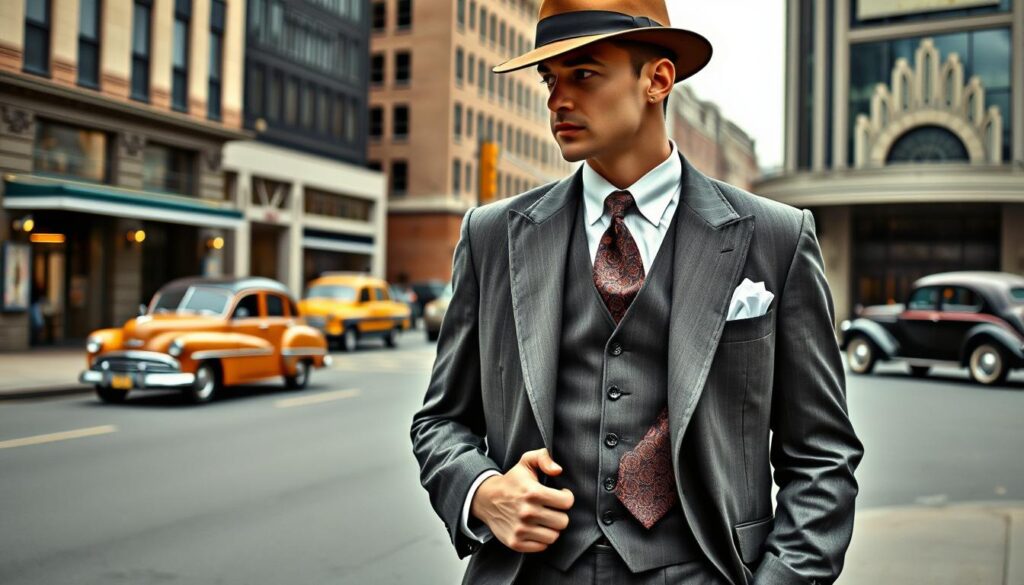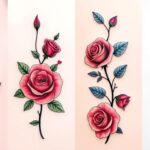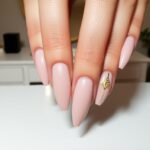1920s fashion men the past whispers through fabric and design, calling us back. 1920s fashion for men was more than clothes—it was a statement. It showed confidence, rebellion, and cultural change.
Those crisp suits and bold accessories tell a story. They go beyond just threads.
Vintage fashion still captures our imaginations, especially the mens vintage fashion 1920s look. About 15% of clothes sold in the U.S. are vintage. Also, 35% of fashion stores see more young adults buying vintage.
The 1920s were a time of big change in men’s fashion. It was a mix of tailored suits and unique accessories. This era showed sophistication and cultural change.
The market for vintage clothes from this time is growing fast. It’s expected to grow by 10% from 2024 to 2030.
Custom-made suits, once for the rich, are now more affordable. They show off the art of fashion. Details like perfect shoulders and chosen fabrics made clothes an art form.
This look into 1920s men’s fashion will show how vintage style shapes today’s fashion. It will also show how it inspires fashion lovers all over the world.
Table of Contents
Introduction to 1920s Men’s Fashion
The roaring 20s brought a big change in men’s clothes. Before, men wore stiff, tight outfits. But the 1920s introduced more relaxed and expressive styles. 1920s men’s style showed a new era of freedom and culture.

The Cultural Revolution of Fashion
After World War I, society changed a lot. This change led to new fashion for men. With more money and freedom, men started to try new styles.
- Casual wear became increasingly acceptable
- Suits transformed from rigid to comfortable
- Colors and patterns became more experimental
Key Trends Defining the Decade
The 1920s men’s style had key trends. Lightweight fabrics like linen and cotton were popular. This showed a move towards comfort and practicality.
| Fashion Element | Characteristic |
|---|---|
| Suit Style | Looser fit, sack suits, double-breasted options |
| Color Palette | Neutral tones with bold accent colors |
| Fabric Preference | Lightweight cotton, linen, wool |
“Fashion is the armor to survive the reality of everyday life.” – Bill Cunningham
The rise of jazz culture changed men’s fashion. It brought more vibrant and expressive clothes. Hollywood stars also influenced style, inspiring nearly 70% of men.
Iconic Styles of the 1920s
The 1920s were a time of big change in men’s fashion. Old dress codes were thrown out, and new, bold styles took their place. These styles showed the cultural shift and how people wanted to express themselves.
The Suit: A Symbol of Masculinity
In the Roaring Twenties, the suit was more than clothes. It was a sign of being a man and having status. Slim, tailored suits with wide lapels were everywhere, showing off the era’s style.
- Suits featured high-waisted trousers
- Jackets became shorter and more fitted
- Popular colors included grey, brown, and blue
Accessories that Made a Statement
Accessories were key in the 1920s. Men picked items that showed who they were and where they stood in society.
| Accessory | Significance |
|---|---|
| Pocket Watches | Symbol of refinement and precision |
| Tie Pins | Added elegance to neckwear |
| Suspenders | Functional and stylish alternative to belts |
“Fashion is a language that creates itself in clothes to interpret reality.” – Karl Lagerfeld
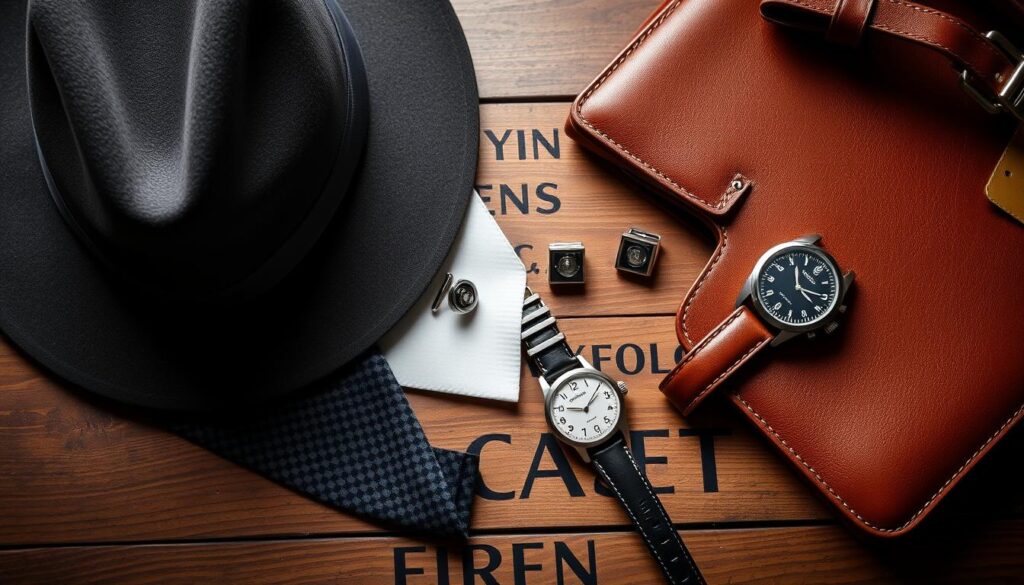
The 1920s saw a big change in men’s fashion. Ready-to-wear clothes grew by 50%, making stylish clothes more accessible. By 1929, almost 40% of American men were looking for fashionable clothes, a big jump from before.
The Evolution of the Men’s Suit
The 1920s were a big change for men’s fashion. Gone were the stiff Edwardian suits, replaced by more relaxed and modern designs. This era saw a big shift in suit styles, showing the changing times.
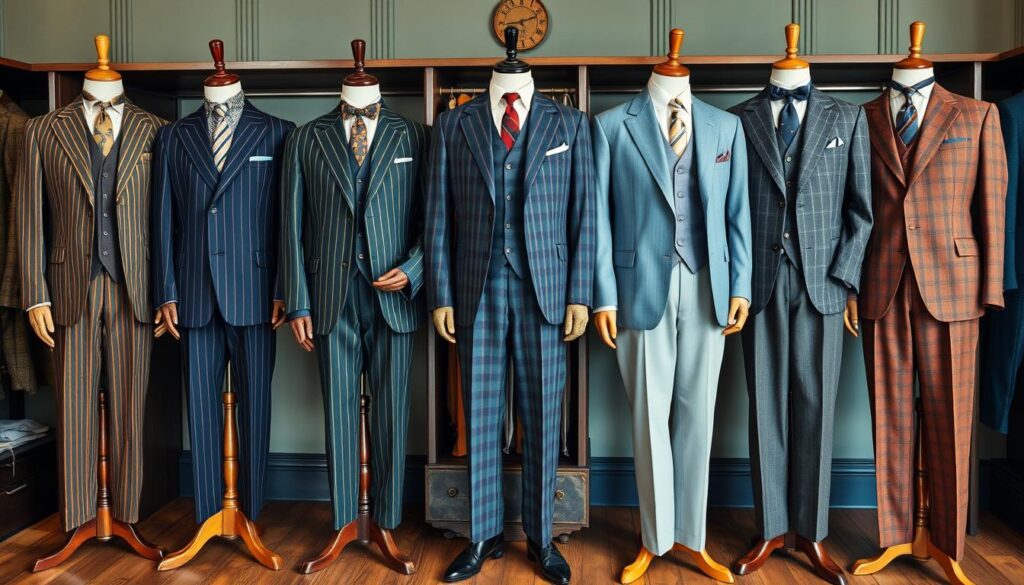
This change was more than just new clothes. It showed a big cultural shift. Men’s clothes became more comfy and showed more personality.
From Rigid to Refined: Suit Silhouettes
- Looser, more relaxed fit replaced tight-fitting Edwardian cuts
- Wider shoulders and straighter leg lines emerged
- Jackets became shorter and more streamlined
Fabrics and Patterns of the Era
The 1920s brought new fabrics to men’s fashion. Designers used lighter, breathable materials. This made clothes more comfortable and flexible.
| Fabric Type | Characteristics | Popularity |
|---|---|---|
| Flannel | Soft, warm, versatile | High |
| Wool Blends | Lightweight, breathable | Medium |
| Tweed | Textured, durable | Growing |
“Fashion is a language that creates itself in clothes to interpret reality.” – Karl Lagerfeld
Patterns were key in 1920s men’s fashion. Pinstripes, checks, and subtle plaids were big hits. They let men show their style while staying professional.
The Rise of Casual Wear
The 1920s were a game-changer for men’s casual fashion. Men started wearing clothes that were more relaxed and comfy. This change showed the era’s lively spirit.
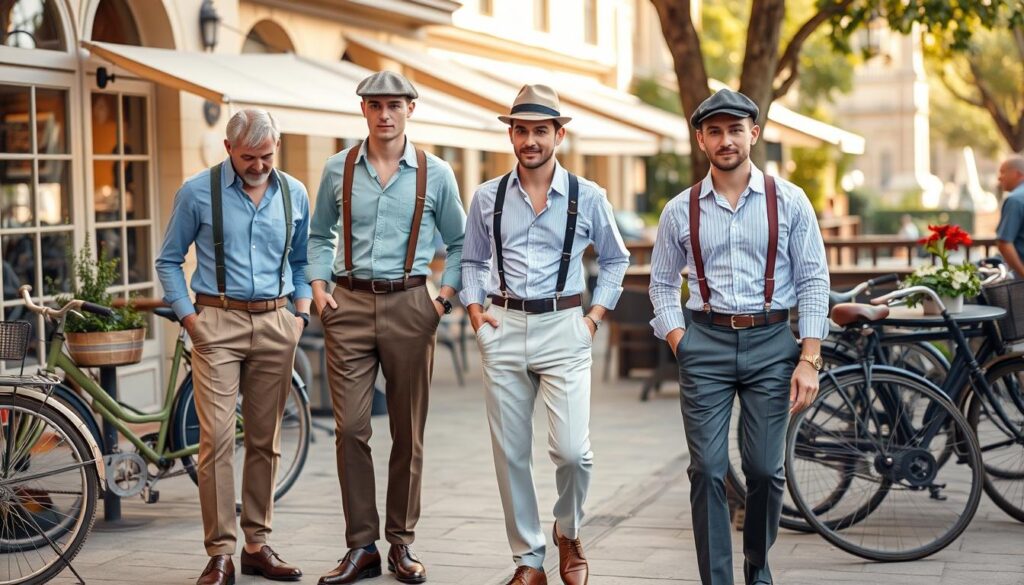
This decade brought new clothes that changed men’s wardrobes. These changes showed a big shift in culture.
Knickerbockers: Sport and Leisure Wear
Knickerbockers became a key piece of casual wear, especially for sports fans. These baggy pants were comfy and let men move freely. Athletic wear at this time was a big change from old, tight clothes.
The Role of Sport Coats
Sport coats became a must-have item. They were light and let men look good while feeling comfy. They were perfect for both formal and casual looks.
- Lightweight fabrics replaced heavy wool
- Looser fits encouraged movement
- Patterns became more adventurous
The 1920s casual wear revolution was more than a trend. It was about freedom and being yourself.
Footwear Trends in the 1920s
The 1920s were a big change for men’s shoes. They brought new designs and choices that showed off a man’s style and status. Shoes were no longer just for walking; they were a way to express who you were.
Men in the 1920s wore unique shoe styles that set the decade’s look. These trends still inspire fashion today.
Oxford Shoes: The Quintessential Classic
Oxford shoes were the top choice in the 1920s. They were the sign of a refined gentleman. They had:
- Sleek leather construction
- Pointed or rounded toe designs
- Typically dark brown or black colors
- Crafted with great detail
Loafers: Introducing Casual Comfort
Loafers were a big change in the 1920s. They were slip-on shoes that were comfy but still stylish. They showed a new side of 1920s men’s style.
Pairing Tips for Authentic 1920s Look
To get the 1920s look right, try these pairing tips:
- Match Oxford shoes with tailored suits for formal events
- Wear loafers with wide-leg trousers for casual events
- Choose leather colors that match your outfit
- Make sure your shoes are shiny
“In the 1920s, a man’s shoes were his silent ambassador of style and status.” – Fashion Historian
Knowing about these shoe trends helps today’s fashion lovers bring back the elegance of 1920s men’s fashion.
The Impact of the Jazz Age
The 1920s were a time of big change in men’s fashion, thanks to the jazz age. Music and style came together, creating a lively cultural scene. Jazz wasn’t just music; it was a force that changed fashion.
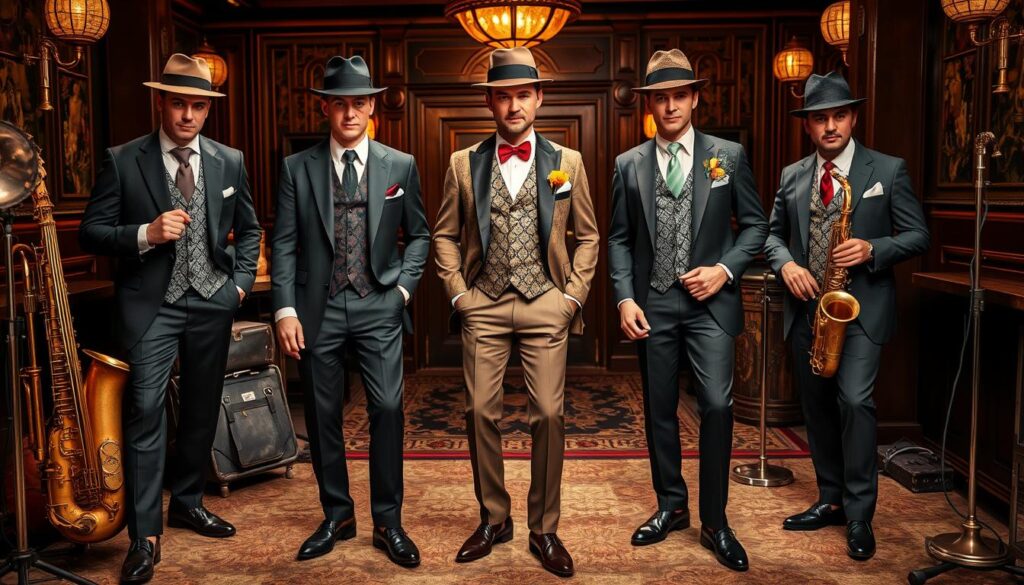
Jazz’s lively beats changed men’s fashion in big ways. Musicians and performers became fashion leaders. They showed men it was okay to wear clothes that were different and free.
Music and Fashion Interconnected
Jazz stood for freedom and being yourself, which showed in clothes. Men started trying new things like:
- Looser suit cuts
- Bolder color combinations
- More relaxed accessories
The Cultural Shift in Styles
The jazz age made men rethink what they wore. They wanted clothes that let them move and showed their fun side. Stars like Louis Armstrong made bold, new looks popular.
“Style is a way to say who you are without having to speak.” – Rachel Zoe
Musicians showed that clothes could be both useful and showy. They broke old fashion rules, starting a new era of freedom in what men wore.
Iconic Fashion Figures of the 1920s
The 1920s men’s style was shaped by cinema and entertainment stars. These stars became fashion icons, influencing men’s fashion across the United States.
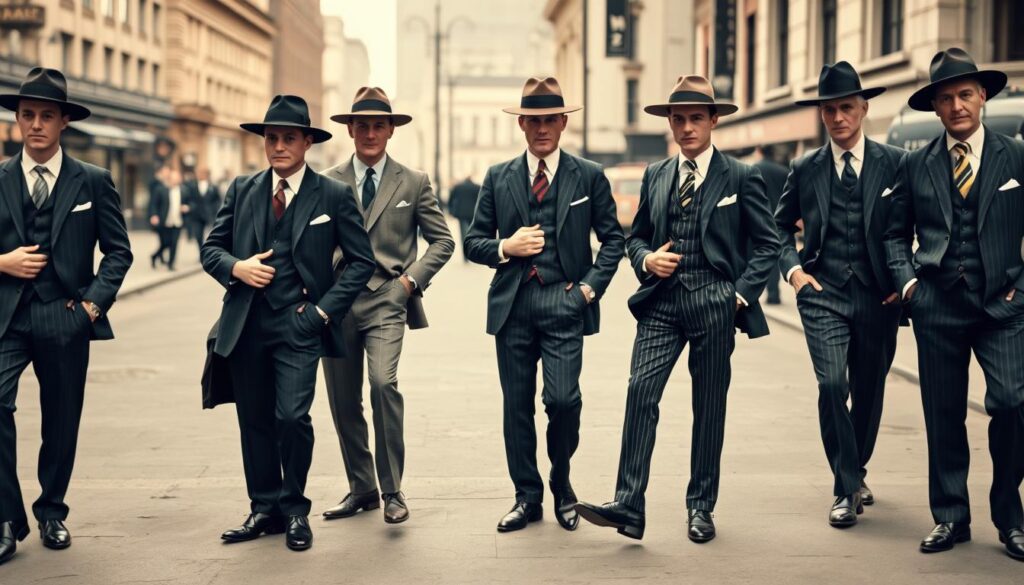
Hollywood was a major trendsetter. Silver screen legends changed men’s fashion with their unique looks and charm.
Charlie Chaplin: The Revolutionary Style Icon
Charlie Chaplin changed men’s fashion with his Tramp character. His outfit—oversized pants, tight jacket, small hat, and mustache—became famous worldwide.
- Popularized baggy pants with high waistlines
- Introduced playful yet sophisticated casual wear
- Influenced international men’s fashion trends
Fashion Icons of the Silver Screen
Actors like Douglas Fairbanks and Rudolph Valentino changed 1920s men’s style. They made tailored suits and accessories popular.
| Actor | Fashion Signature | Style Impact |
|---|---|---|
| Douglas Fairbanks | Athletic, well-fitted suits | Popularized muscular, athletic masculine look |
| Rudolph Valentino | Elegant evening wear | Introduced romantic, sophisticated European style |
“Fashion is architecture: it is a matter of proportions.” – Coco Chanel
These style pioneers didn’t just wear clothes—they created cultural movements. They redefined masculinity and men’s fashion for future generations.
The Role of Prohibition in Men’s Fashion
The 1920s Prohibition era changed American society and men’s fashion. With alcohol banned, secret social scenes popped up. These scenes led to new fashion trends for men.
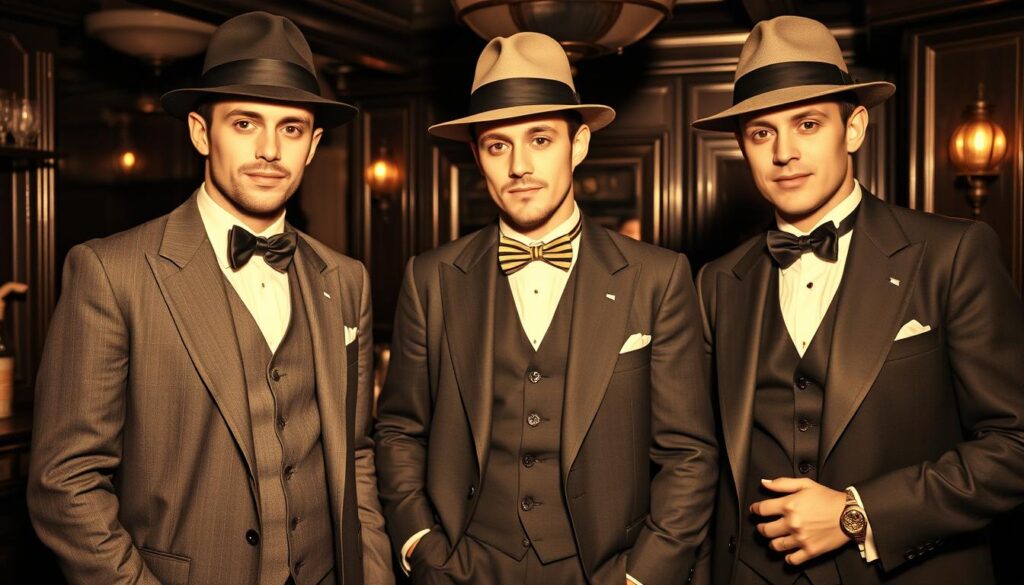
In this time, men’s fashion showed the era’s rebellious spirit. Speakeasies, secret bars, became places where men showed off their style through clothes.
Social Norms Redefined
Prohibition changed how people interacted, making fashion more bold. Men’s clothes became a way to communicate without words. Accessories and styles showed who belonged in certain groups.
- Elaborate pocket squares became secret identifiers
- Unique hat styles indicated social connections
- Tailored suits suggested sophistication
Speakeasy Style Essentials
Speakeasies, hidden bars, needed eye-catching outfits. Men tried new patterns and tailoring to stand out in these secret spots.
| Clothing Item | Speakeasy Significance |
|---|---|
| Three-piece suits | Signaled social status |
| Wide-lapel jackets | Demonstrated rebellious style |
| Fedora hats | Marked individual personality |
“Fashion is the armor to survive the reality of everyday life.” – Bill Cunningham
The Prohibition era’s fashion was a bold statement. Men used style as a form of personal expression. They turned limits into chances for creative fashion.
Accessories that Defined the Decade
The 1920s changed how men dressed, making their style sophisticated and unique. This era’s fashion was all about bold statements through accessories.

Men’s fashion in the 1920s turned accessories into more than just useful items. They became key parts of a man’s style, showing off his personality and status.
Iconic Headwear: Hats that Spoke Volumes
Hats were more than just for keeping warm in the 1920s. They were key to a man’s look, showing off his style.
- Fedoras: Symbolic of sophistication and urban cool
- Newsboy Caps: Popular among working-class and artistic crowds
- Bowler Hats: Representing traditional elegance
Refined Finishing Touches: Cufflinks and Pocket Squares
Small accessories had a big impact in the 1920s. Cufflinks and pocket squares were more than just decorations. They showed off a man’s personal style.
| Accessory | Popularity | Style Significance |
|---|---|---|
| Cufflinks | 90% of formal wear | Personal expression |
| Pocket Squares | 60% regular use | Outfit refinement |
*”In the 1920s, a gentleman was defined not just by his suit, but by his accessories.”*
If you’re new to vintage fashion, start with one bold piece. A big ring or a classic fedora can make your look pop.
Colors and Patterns of the 1920s
The 1920s brought a burst of color and patterns to men’s fashion. Men’s clothes moved from simple designs to bold statements. These changes showed the era’s lively spirit.
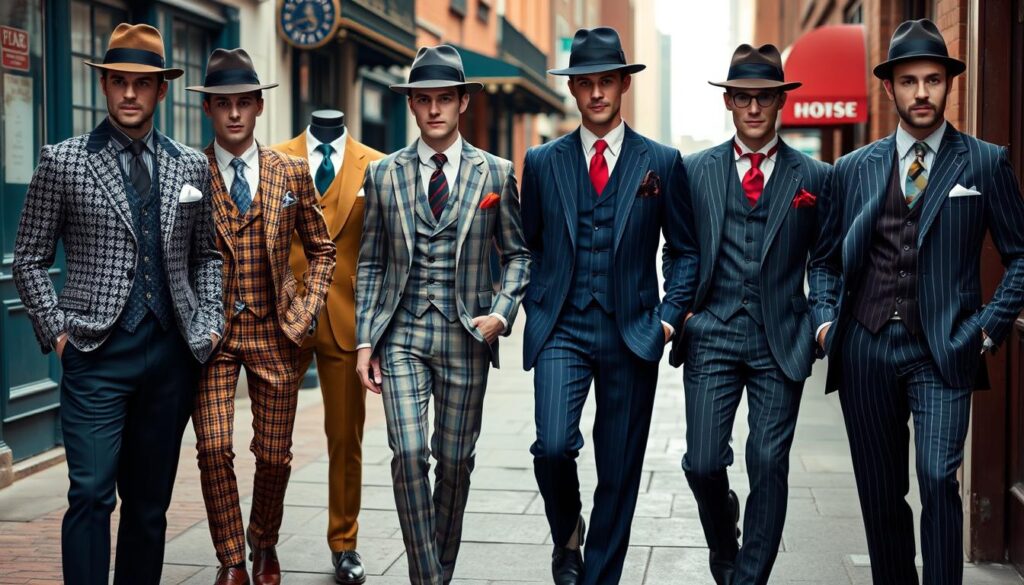
Men in the 1920s fashion men loved a wide range of colors. They broke away from old style rules. Designers and fans tried new ways to show their style.
Bold Patterns and Bright Hues
Colors changed a lot in the 1920s. While gray and navy were still popular, brighter colors became trendy:
- Vibrant greens
- Passionate reds
- Sunny yellows
- Rich emerald tones
The Use of Stripes and Checks
Patterns became key in 1920s men’s fashion. Suits and accessories had striking designs that stood out.
| Pattern Type | Popularity | Typical Usage |
|---|---|---|
| Pinstripes | 70-80% | Business Suits |
| Checks | 50-60% | Casual Jackets |
| Bold Windowpane | 40-50% | Sport Coats |
The bold patterns were more than just fashion. They showed a big change in men’s style.
“Fashion is the armor to survive the reality of everyday life.” – Bill Cunningham
Tailoring Techniques of the 1920s
The1920s fashion menwere all about precision and personal style in men’s formal wear. Tailoring was more than clothes; it was a way to show off one’s individuality and social status. Skilled craftsmen turned fabric into wearable art with great attention to detail.
The Importance of Fit
Fit was key in 1920s men’s fashion. This era saw a big change in how clothes were made, focusing on each person’s body shape. A well-fitted suit could make a man look his best.
- Suits were cut to highlight natural body lines
- Shoulder width became a critical measurement
- Trousers emphasized clean, straight silhouettes
Custom Suits vs. Ready-to-Wear
The 1920s were a turning point for men’s clothing. Custom suits were once the norm, but ready-to-wear started to become popular.
| Custom Suits | Ready-to-Wear |
|---|---|
| Personalized measurements | Standardized sizing |
| Higher cost | More affordable |
| Unique fabric selections | Limited fabric options |
“A well-tailored suit is to women what a beautiful naked body is to men.” – Unknown Fashion Critic
About 40% of men’s suits sold then were sack suits. They had little shoulder padding and a loose fit. Ready-to-wear clothing made fashion more accessible to more people.
By the late 1920s, double-breasted suits made up about 30% of sales. This shows how men’s fashion was changing. Tailors and makers had to balance old skills with the need for quick, affordable clothes.
Fashion Magazines and Trends
The 1920s saw a big change in how men’s fashion was shared through print. Fashion magazines became key players in shaping men’s style. They had a huge impact on how men looked and dressed.
Publishing houses were key in spreading style news in this exciting decade. Magazines told stories with pictures, introducing new trends. They used detailed illustrations that showed the era’s elegance.
Magazines Transforming Men’s Fashion Landscape
Many important magazines shaped the fashion world:
- Esquire Magazine – launched in 1933, setting menswear standards
- Vanity Fair – featuring cutting-edge fashion editorials
- GQ’s predecessor publications – highlighting gentleman’s style
Visual Storytelling and Style Inspiration
These magazines did more than show clothes. They turned fashion into stories men wanted to follow. Detailed fashion illustrations showed new social trends. They helped men see fashion in a new light.
“Fashion is architecture: it is a matter of proportions.” – Coco Chanel
By using beautiful illustrations and photos, magazines made fashion open to all. This made high fashion available to men from all walks of life in the lively Roaring Twenties.
The Role of Hollywood in Fashion Trends
The 1920s saw a big change in men’s style, thanks to Hollywood. Film stars became fashion icons, changing how men dressed with their on-screen looks.
Hollywood changed men’s fashion in big ways. Stars like Douglas Fairbanks and Rudolph Valentino set new fashion trends. They showed men how to dress, creating new ideas of masculinity.
Film Stars and Their Signature Looks
The movies introduced key style elements for 1920s men’s fashion:
- Tailored suits with wider lapels
- High-waisted trousers
- Relaxed yet structured silhouettes
- Accessories like pocket squares and fedoras
The Spread of Style Through Cinema
Cinema was a key way to share fashion. Men’s fashion magazines and stores made Hollywood styles available to everyone. This made stylish clothes more accessible.
“Style is a way to say who you are without having to speak.” – Rachel Zoe
Roaring 20s fashion for men was more than clothes. It was a way to show who you were. Hollywood made fashion a national trend, showing what it meant to be a man.
| Hollywood Star | Signature Style Element | Cultural Impact |
|---|---|---|
| Charlie Chaplin | Oversized Trousers | Comedic Charm |
| Rudolph Valentino | Tailored Suits | Romantic Masculinity |
| Douglas Fairbanks | Sports Jackets | Athletic Sophistication |
The influence of Hollywood made men’s fashion exciting and inspiring. It still influences style today.
How to Achieve a 1920s Inspired Look
Creating a modern look inspired by 1920s menswear is all about creativity and attention to detail. The 1920s offer a wealth of inspiration for today’s men who want to add a vintage touch to their style.
Essential Pieces to Collect
Starting a vintage-inspired wardrobe means finding key pieces that capture the 1920s spirit. Here are some timeless items to add to your collection:
- High-waisted wool trousers with classic pleats
- Suspenders in neutral or bold colors
- Wingtip oxford shoes in rich leather tones
- Newsboy caps or fedoras
- Vintage-inspired blazers with wide lapels
Styling Tips for Modern Wear
Merging vintage with modern pieces creates a stylish look that honors the Roaring Twenties. The key is balance and personal confidence. Here are some styling tips:
- Pair a modern slim-fit shirt with vintage suspenders
- Combine contemporary trousers with classic wingtip shoes
- Layer a vintage blazer over a current casual outfit
“Style is a way to say who you are without having to speak.” – Rachel Zoe
Authenticity comes from how you wear your clothes, not just the clothes themselves. Wear your vintage-inspired outfit with confidence and your own unique style.
Conclusion: The Legacy of 1920s Fashion
The 1920s fashion for men has a lasting effect on today’s men’s clothing. Back then, about 70% of men chose comfort over traditional styles. This decade changed how we think about fashion, making it more about personal expression.
Today, designers still find inspiration in the 1920s. The iconic sack suit, for example, was a big hit, showing up in 40% of men’s suits by the end. Hollywood stars like Rudolph Valentino also influenced fashion, with over 50% of men wanting to look like them.
Vintage style is more than just clothes; it’s a symbol of freedom and confidence. The 1920s fashion men brought us tailored accessories and relaxed fits that celebrate who we are. This fashion philosophy is still with us, showing that true style knows no bounds.
Today’s Influence on Contemporary Styles
Designers today keep the 1920s spirit alive in their work. They mix comfort with elegance, just like the men of that time. This blend is seen in wardrobes all over the world.
Why Vintage Style Remains Timeless
True style never goes out of fashion. The 1920s showed us that fashion is about expressing ourselves, feeling confident, and challenging the norm. These values are just as important today as they were a century ago.

